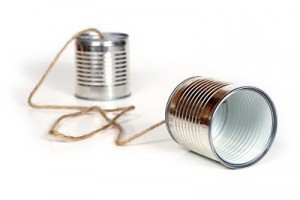 This is the experiment that all kids know about… if you haven’t done this one already, put it on your list of fun things to do. (See the tips & tricks at the bottom for further ideas!)
This is the experiment that all kids know about… if you haven’t done this one already, put it on your list of fun things to do. (See the tips & tricks at the bottom for further ideas!)
We’re going to break this into two steps – the first part of the experiment will show us why we need the cups and can’t just hook a string up to our ear. Are you ready?
You need:
- Table
- Spoon (or whatever is handy)
- Partner
1. Sit at a table.
2. Have your partner sit at the other end of the table.
3. Have your partner very lightly scratch the table with the spoon.
4. Listen to see if you can hear it.
5. While your partner is scratching, put your ear on the table. Do you hear a difference in the sound?
6. Switch roles so your partner gets a chance to try.
Did you notice how you could hear the soft spoon-scratching sound (I love a good alliteration) quite clearly when your head was on the table? The sound waves moved quickly through the table so they lost little of the loudness and quality of the original sound. When sound travels through the air, the sound energy gets dispersed (spread out) much more than through the table, so the sound does not travel as far nor as clearly. This next one is an oldie but a goodie!
A Couple Cups of Conversation

1. Using the scissors or a nail poke a hole in the middle of the bottom of both cups. Get an adult to help you with this. Since this isn’t biology, no bleeding allowed!
2. Thread an end of the string through the hole in the bottom of the cup and tie a big knot in it to keep it from sliding through the hole.
3. Do the same thing with the other cup so that when you are done you have a cup attached to both ends of the string.
4. Take one of the cups for yourself and hand the other cup to your partner. Walk apart from one another until the string is fairly taut.
5. Have your partner hold the cup up to his or her ear while you whisper into your cup.
6. Can your partner hear you? If not, see if you can stretch the string a little more.
7. Switch roles and try again.
The string being a solid and having tightly packed molecules allows the sound wave to move quickly and clearly through it. You can talk very quietly in one cup and yet your partner can still hear you fairly well.
Tips & Tricks
You can try different types of cups (foam, plastic, metal (like tin foil), paper…) and also change the sizes of the cups – is bigger or smaller better? You can also change the connection between the cups – have you tried yarn, wool, string, nylon fishing line, rope, clothesline, or a braided combination? You can also stick a slinky in place of the string of ‘space phones’.
